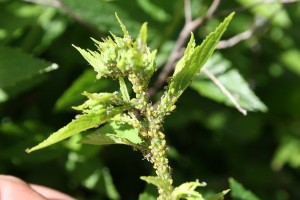–by Dr. Raymond Cloyd
Spirea aphid (Aphis spiraecola) is present feeding on spirea (Spiraea spp.) plants in landscapes. Spirea aphid colonies aggregate on terminal growth (Figures 1 and 2) and their feeding causes leaf curling and stunted plant growth. Spirea aphids prefer to feed on stems and leaf undersides of succulent plant growth. All mature aphids are parthenogenic (reproduce without mating) with females giving birth to live nymphs, which themselves are females. Eggs are laid on bark or on buds in the fall by wingless females after having mated with males. Eggs hatch in spring, and young nymphs develop into stem mothers that are wingless. Spirea aphid females are pear-shaped and bright yellow-green. Stem mothers reach maturity in about 20 days. Each spirea aphid female can produce up to 80 offspring or young females.

Figure 1: Spirea Aphids Feeding on Spirea Plant

Figure 2: Spirea Aphids Aggregation on Terminal Growth of Spirea Plant
Although the aphids produce honeydew (sticky, clear liquid); continual rainfall will wash the honeydew off plants. In the summer, both winged and non-winged aphids may be present. The winged forms usually appear when conditions become crowded on infested plants, in which they migrate to a more suitable food source, such as another spirea plant to start another colony. Heavy rainfall and strong winds will dislodge spirea aphid populations from plants onto the ground, where they eventually die. Frequent applications (twice per week) of forceful water sprays will quickly remove spirea aphid populations without disturbing natural enemies such as parasitoids and predators. They have a number of natural enemies including: ladybird beetles, green lacewings, and hover flies that may help to regulate spirea aphid populations.
Spirea aphids are, in general, exposed to regular applications of pesticides such as insecticidal soaps (potassium salts of fatty acids) and/or horticultural oils (petroleum, mineral, or neem-based) that may be effective in suppressing populations of spirea aphid. These pesticides have contact activity only, so thorough coverage of all plant parts is important. Furthermore, these pesticides are generally less harmful to natural enemies compared to conventional pesticides.



